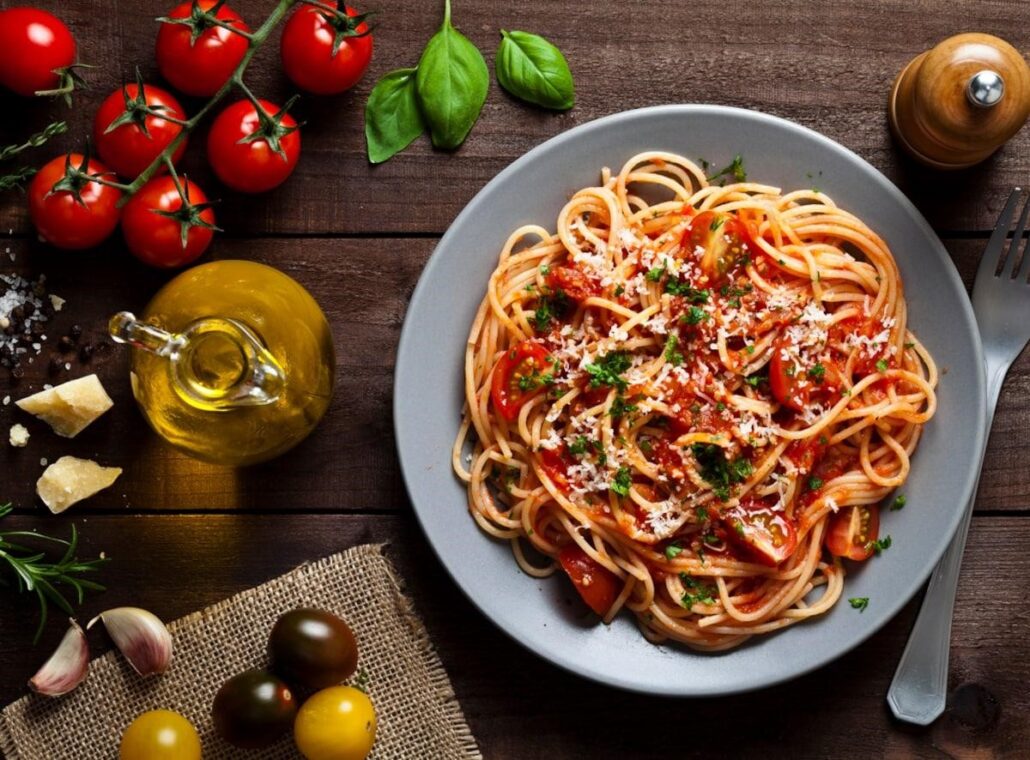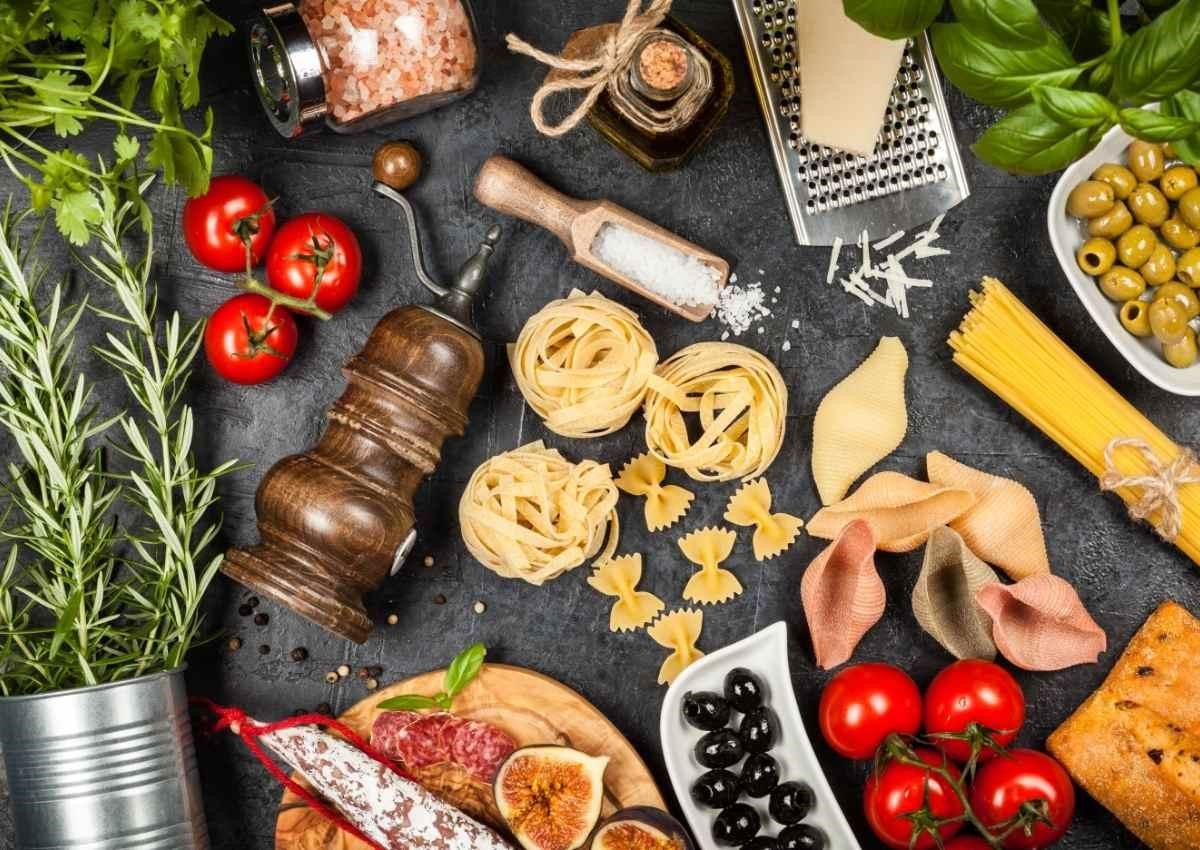Italian national cuisine is so rich and multifaceted that it is an independent symbol of this great country, along with history, architecture, fashion and sights. Tourists and gourmets from all over the world come to Italy for the delicious food of its restaurants, quality products, fragrant herbs and delicate desserts. Italians are very picky while choosing ingredients for their culinary masterpieces, and the cooking process itself, which in Italian cooking is truly creative.
The peculiarity of Italian cuisine is that the chefs at local restaurants always try to use only seasonal products for their masterpieces that are not subject to freezing or transportation. That way the food becomes both tastier and much healthier. Precisely these properties justify the Italian food its incredible caloric content, which does not prevent, however, to remain at the top of popularity throughout the world just restaurants Italian cuisine.
HISTORY OF DEVELOPMENT AND FORMATION
Italian cuisine has always been distinguished by its taste and aesthetic characteristics. Italians learnt to appreciate all these qualities during the Roman Empire that existed on the territory of modern Italy from 27 B.C. till 476 A.D.
In those days, the Roman emperors constantly arranged feasts with a lot of delicious exotic dishes. This period is the starting point in the emergence of modern Italian cuisine. And not only Italian cuisine, as the Roman Empire had a great influence on other states that were its parts, that’s why dishes of Italian cooks were spreading gradually throughout the world, improving and changing, becoming habitual for tastes of people in many countries of the world.
The culinary art of Italy culminated in the 16th century, when the Vatican published a cookbook “Of true pleasures and prosperity,” subsequently reprinted six times. After its publication cookery began to be studied as a science; it was elevated in Italy to the rank of a true art; the first culinary schools were founded in Florence, where the first certified Italian chefs learned the wisdom of cooking and serving food.
The history of Italian cuisine helps to understand its peculiarities, first of all, the regional character of many dishes. Historically, northern Italian cuisine has always been very rich; it is in this part of the country that the masterpieces of world cookery originated. Northern Italy is considered the birthplace of pasta, which was usually cooked with eggs and cream.
PRODUCTS OF ITALIAN CUISINE.
In Italy it is customary to cook exclusively with their own regional products, fortunately the country is quite rich in a variety of plant and animal gifts. Many of the famous sauces Italians make from fresh fruits and vegetable:
- Tomatoes,
- carrots,
- peppers,
- potatoes,
- zucchini,
- asparagus,
- celery,
- onions.
They are used as ingredients for salads, as side dishes, and as appetizers. The Mediterranean climate is favorable for growing and eating:
- apricots,
- all kinds of citrus fruits,
- cherries,
- grapes,
- strawberries,
- raspberries,
- kiwi,
- apples,
- plums,
- peaches,
- blueberries.
All sorts of seafood and fish of different kinds are used by Italians for cooking soups, main courses and snacks. Cheeses and dairy products enjoy great popularity and are eaten both fresh and as a base for Italian salads, desserts, sauces. Many kinds of meat the locals also like to replace cheeses, considering it more healthy. But still in Italy they actively eat lean pork, beef, chicken and other poultry.
Italian cuisine, which national dishes are famous for the abundance of ingredients, is unthinkable without the base of any food – olive oil. Olive oil was highly valued even in Roman times, because even then all its useful qualities were clear and revealed its beneficial effects on the human body. In modern Italian cooking olive oil replaces absolutely any fat, sauce or seasoning. At least, popular in other countries sunflower oil in the culinary traditions of Italy is not listed at all.
Grass in Italian cuisine is a separate line of poetic perception of reality through the prism of cooking. In this country herbs can make the main sounding in absolutely any dish. Meat and vegetables cannot be cooked in Italian without using herbs.
Many dishes are prepared with:
- basil,
- sage,
- oregano,
- marjoram,
- saffron,
- garlic,
- rosemary,
- cumin.
Also Italians skilfully cook and eat various kinds of mushrooms, beans, rice and other cereals, chestnuts, and nuts. The traditional drink of Italy has always been and remains high-quality wine. Without wine there is hardly a meal in an Italian café or at home. Among the traditional ways of cooking in Italian cuisine are stewing, frying, boiling and baking. It’s the way food has been prepared since Roman times and the chefs at classic Italian restaurants are in complete solidarity with their forefathers in this matter.
TRADITIONAL DISHES
Italian cuisine is the subject of endless discussion because of its variety, grandeur and sophistication. Still, there are a few dishes in the world, naming which, it’s impossible to think of anything else but Italy. These traditional Italian delicacies include pesto sauce, pizza, pasta, risotto, caprese salad, and tiramisu dessert. Recipes for Italian home cooking today allow housewives around the world to repeat the culinary masterpieces of Italian chefs, because many of the incredibly tasty dishes are very easy to prepare. The main thing is to choose the highest quality products for each dish.
Pesto is an Italian sauce prepared from fresh basil leaves, natural cheese, pine nuts and olive oil. In general, Italy is a country of sauces. There are more than a thousand recipes, and they are all incredibly delicious and help you experience the taste of previously familiar dishes in a new way.
There is probably no person in the world who has never tried pizza. Italian recipes at home allow modern housewives to prepare pizza with all sorts of toppings. However, the classic recipe for this dish involves a round flatbread on which tomatoes and cheese are baked in the oven sprinkled with spices. In Italy itself today there are hundreds of pizza recipes.
The flatbread for this dish also varies, depending on the region of the country. In the south prefer to bake pizza on a thin dough, while in the north, on the contrary – on a thick one. Despite the general recognition of pizza as a classic Italian dish, scientists agree that the real homeland of this dish is not Italy, but Greece.
The baking talents of the Greeks once led to the first people in the world to put cheese on the dough and bake it, calling the dish “plakuntos. However, pizza spread to Europe in the 17th century, when Neapolitan sailors quickly spread it to various countries. One of the most famous varieties of pizza is so called – Neapolitan.

Neapolitan pizza in Italy has well-defined quality standards, it is protected by law, which prescribes the size, quality of yeast and flour from which the pizza is baked, type of tomato and other ingredients for cooking. Italian cuisine restaurants, cafes and pizzerias which are able to meet all those standards, can mark their dishes with a special seal of quality that guarantees the use of a classic recipe of Neapolitan pizza in their establishments.
Pasta is a classic Italian dish representing ordinary pasta with various fillings and sauces. There are a huge number of pasta recipes on the menu of Italian cuisine. It’s worth considering a homemade recipe for making the most famous pasta – carbonara.
Carbonara is actually the name of the sauce for pasta. Carbonara sauce can be made from finely chopped slices of bacon, brisket and ham. However, the classic Italian pasta carbonara recipe uses guanchiale – raw pork cheeks. Also Italians can use pancetta – fatty pork brisket, with salt, spices, sage and rosemary – for the carbonara sauce. As a base, most often in carbonara use regular spaghetti.
So, the ingredients for pasta carbonara according to the recipe of Italian cuisine at home are:
- spaghetti – 250 grams;
- bacon or ham (or guanchiale, pancetta) – 200 grams;
- olive oil – a tablespoon;
- Parmesan cheese – 30 grams;
- garlic – 1 clove;
- eggs – 3 pieces;
- salt and pepper – to taste.
Spaghetti for carbonara is better cooked whole, not breaking in the pot, as is often done. Cooking time for spaghetti is usually indicated on the package with the pasta. Cook them in slightly salted water. You need to heat olive oil well in a frying pan and fry the finely chopped garlic in it.
After the garlic gives aroma to the oil, its pieces should be removed from the oil. Bacon, ham or guanchiale is cut into cubes for the carbonara and fried in the garlic flavored olive oil. In a separate bowl, beat 1 whole egg and the yolks from the other two. With a fork, beat the eggs, adding the pepper to them. Into the homogeneous egg mixture you need to grate Parmesan on a fine grater, then mix everything thoroughly.
The resulting sauce should have the consistency of thick sour cream. If it is thicker and more viscous, you can liquefy it by adding some of the liquid in which the spaghetti is boiled. Drain the spaghetti, strain it in a colander, and then transfer it to a deep container. Add the fried bacon and egg and parmesan sauce.
All the ingredients are stirred vigorously so that the sauce evenly covers all the cooked pasta. Pasta carbonara is served hot, freshly cooked. Another famous and authentic Italian dish is risotto. Risotto is prepared using rice stewed in broth and wine, mushrooms, meat, various vegetables or seafood.
As in other dishes of Italian cuisine, risotto recipes have many nuances, they vary from region to region, from restaurant to restaurant. Caprese salad is a type of traditional appetizer in Italy.
